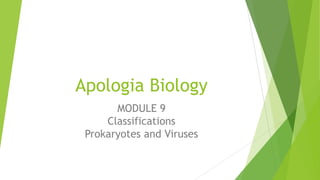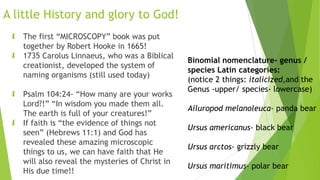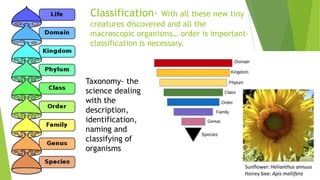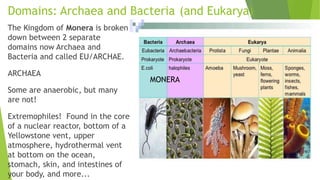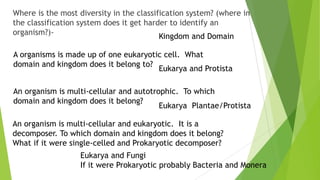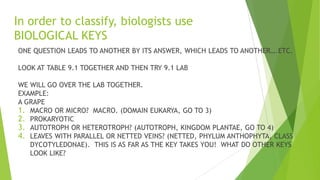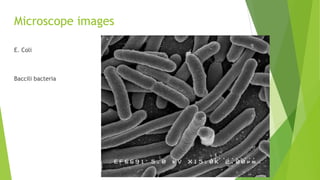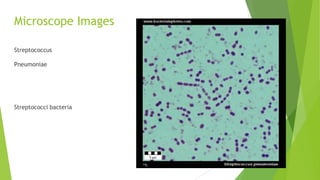Apologia Biology - updated Module 9 & 10 (bact virus) (protist fungi).pptx
- 1. Apologia Biology MODULE 9 Classifications Prokaryotes and Viruses
- 2. A little History and glory to God! ’āÅ The first ŌĆ£MICROSCOPYŌĆØ book was put together by Robert Hooke in 1665! ’āÅ 1735 Carolus Linnaeus, who was a Biblical creationist, developed the system of naming organisms (still used today) ’āÅ Psalm 104:24- ŌĆ£How many are your works Lord?!ŌĆØ ŌĆ£In wisdom you made them all. The earth is full of your creatures!ŌĆØ ’āÅ If faith is ŌĆ£the evidence of things not seenŌĆØ (Hebrews 11:1) and God has revealed these amazing microscopic things to us, we can have faith that He will also reveal the mysteries of Christ in His due time!! Binomial nomenclature- genus / species Latin categories: (notice 2 things: italicized,and the Genus -upper/ species- lowercase) Ailuropod melanoleuca- panda bear Ursus americanus- black bear Ursus arctos- grizzly bear Ursus maritimus- polar bear
- 3. Classification- With all these new tiny creatures discovered and all the macroscopic organismsŌĆ” order is important- classification is necessary. Taxonomy- the science dealing with the description, identification, naming and classifying of organisms
- 4. Domains: Archaea and Bacteria (and Eukarya) The Kingdom of Monera is broken down between 2 separate domains now Archaea and Bacteria and called EU/ARCHAE. ARCHAEA Some are anaerobic, but many are not! Extremophiles! Found in the core of a nuclear reactor, bottom of a Yellowstone vent, upper atmosphere, hydrothermal vent at bottom on the ocean, stomach, skin, and intestines of your body, and more... MONERA
- 5. Where is the most diversity in the classification system? (where in the classification system does it get harder to identify an organism?)- Kingdom and Domain A organisms is made up of one eukaryotic cell. What domain and kingdom does it belong to? Eukarya and Protista An organism is multi-cellular and autotrophic. To which domain and kingdom does it belong? Eukarya Plantae/Protista An organism is multi-cellular and eukaryotic. It is a decomposer. To which domain and kingdom does it belong? What if it were single-celled and Prokaryotic decomposer? Eukarya and Fungi If it were Prokaryotic probably Bacteria and Monera
- 6. In order to classify, biologists use BIOLOGICAL KEYS ONE QUESTION LEADS TO ANOTHER BY ITS ANSWER, WHICH LEADS TO ANOTHERŌĆ”.ETC. LOOK AT TABLE 9.1 TOGETHER AND THEN TRY 9.1 LAB WE WILL GO OVER THE LAB TOGETHER. EXAMPLE: A GRAPE 1. MACRO OR MICRO? MACRO. (DOMAIN EUKARYA, GO TO 3) 2. PROKARYOTIC 3. AUTOTROPH OR HETEROTROPH? (AUTOTROPH, KINGDOM PLANTAE, GO TO 4) 4. LEAVES WITH PARALLEL OR NETTED VEINS? (NETTED, PHYLUM ANTHOPHYTA, CLASS DYCOTYLEDONAE). THIS IS AS FAR AS THE KEY TAKES YOU! WHAT DO OTHER KEYS LOOK LIKE?
- 7. 2ND PART OF CHAPTER: Kingdom Monera Kingdom Monera: some scientist call them Prokaryotes or EUBacteria and Archaebacteria Prokaryotes: single cell organisms with no nuclear membrane or membrane bound organelles This Photo by Unknown Author is licensed under CC BY-SA
- 8. BACTERIA!!! The good, the bad, and the MARINE! Bad: Pathogenic bacteria that cause diseases E. coli (certain strains), pneumonia, measles, Smallpox, streptococcus (certain strains), staph Good or neutral: gut microbiome (breaks down food, makes vitamins); yogurt, cheese, fermented foods Marine-- Either decomposers or Cyanobacteria: Classified as a blue- green algae that requires light to survive which is not the norm for most bacteria that prefer dark, damp places to multiply. They live in colonies.
- 9. Bacteria Or fimbria In cytoplasm: DNA (organized into chromosomes) and ribosomes Outside: pili (on some bacteria) and flagella for motility (on some bacteria)
- 10. Bacteria in the Ocean Decomposers live all over the ocean floor and are essential for clean up! Some bacteria live near hydrothermal vents and chemosynthesize. Cyanobacteria are the only photosynthetic prokaryotes able to produce oxygen and fix nitrogen. This Photo by Unknown Author is licensed under CC BY-SA
- 11. Shapes of Bacteria Coccus (pl cocci) Bacillus (pl bacilli) Spirillum (pl spirilla)
- 12. Microscope images E. Coli Baccili bacteria
- 14. Microscope Images Helicobacter pylori Spirillum bacteria
- 15. Feeding of Bacteria Most are heterotrophic (needing to feed on something!) Saprophytes (decomposers): Break down dead organisms, vital to our soil and the ocean! Secrete extracellular enzymes to break down organism Parasitic (feeding on living host) Take nutrients from host (harming host) This Photo by Unknown Author is licensed under CC BY
- 16. Feeding of Bacteria Some are Autotrophs: Make their own food via: Photosynthesis (e.g. cyanobacteria) Chemosynthesis (e.g. nitrifying bacteria in soil) Sulfur bacteria, iron bacteria) Photosynthetic - Fix nitrogen and produce oxygen. But can cause problems too if blooms occur. Chemosynthetic- convert energy from inorganic molecules instead of sunlight. These are called chemoautotrophs. This Photo by Unknown Author is licensed under CC BY-NC-ND
- 17. Oxygen ’üĄAerobic bacteria - requires oxygen ’üĄAnaerobic bacteria -- lives without oxygen ’üĄex. bacteria in the bottom of a swamp ’üĄWastewater treatment plants ŌĆō ’üĄstinky without oxygen This Photo by Unknown Author is licensed under CC BY-NC-ND
- 18. Endospores When subjected to extreme conditions, bacteria can create endospores. A thick internal wall made of several hard layers, produced by the bacterium, that encloses its DNA and other essential parts.
- 19. Blue Green Algae Now called cyanobacteria (because they arenŌĆÖt algae) Photosynthetic and require light for metabolism Found everywhere on earth that there is water - even the arctic!
- 20. Reproduction in bacteria- ’āÅ Bacteria can be specialized for a certain habitatŌĆ”when taken out of that environment they can die. Conditions for bacterial growth: ’āÅ Moisture- their capsules and endospores help them through mild dry spells. ’āÅ Moderate temperature- most prefer 80 to 100 f, making summer most ideal ’āÅ Darkness- exeptions being photosynthetic bacteria ’āÅ Oxygen- in the proper amounts depending on the bacteria ’āÅ Bacteria only reproduce asexually through Binary Fission ’āÅ Begins when dna forms a loop attached to the plasma membrane that then copies itself. ’āÅ Once replicated, it attaches to plasma membrane near original and the cell wall and membrane begin to elongate. ’āÅ They separate and the new plasma membrane and cell wall begin to grow. Now two identical cells
- 21. ’āÅ Sometimes mutations occur which make the offspring slightly different ’āÅ Bacteria reproduce in about 20 minutes making it possible to have more than a billion offspring in 10 hours. Bacteria can also exchange genetic information to survive. -Conjugation is a temporary union of 2 organisms for the purpose of DNA transfer. If individuals with different traits that are desirable and would benefit the population, these organisms could perform conjugation. (these traits are usually in the plasmid). The donor give the recipient his special F factor (fertility factor). Through a conjugation tube, the F factor is transferred. -Transformation is another way of transferring a DNA segment from a nonfunctional donor cell to a functional recipient cell. When bacteria die, their DNA breaks apart and is sensed by a living bacterium. The living bacterium can take and absorb those traits (new genetic information or plasmid). -Transduction takes place when a virus infects a bacterium and transfers DNA from one to another.
- 24. ’üĄ Fresh water and marine Amoeba and Paramecium animal-like Protists https://www.wxii12.com/article/individual-dies-after-bacteria- illness-from-fresh-water-in-cumberland-county/28509115# Non photosynthetic Click here for news
- 25. ’üĄ Euglena ’üĄ Algae ’üĄSingle celled ’üĄPhytoplankton ’üĄ Cyanobacteria ’üĄ Diatoms ’üĄ Dinoflagellates ’üĄMulti-celled ’üĄSea weeds
- 26. Diatoms and Dinoflagelletes https://www.youtube.com/watch?v=1-sQBOQOLCM https://www.youtube.com/watch?v=GFwztOsWHN4 Dinoflagellates are unicellular protists which exhibit a great diversity of form. ... When this happens many kinds of marine life suffer, for the dinoflagellates produce a neurotoxin which affects muscle function in susceptible organisms. Humans may also be affected by eating fish or shellfish containing the toxins. https://ocean.si.edu/ocean- life/invertebrates/glowing-dinoflagellate-meal https://www.youtube.com/watch?v=uqJbUKEPgXc
- 28. Seaweed ’üĄ Seaweeds are algae that live in the sea or in brackish water. Scientists often call them "benthic marine algae", which just means "attached algae that live in the sea". ’üĄ There are about 10,000 species of seaweeds ’üĄ three basic colors: red, green, and brown ’üĄ Brown are in salt water (Kelp/Sargassum) ’üĄ Green often in fresh water (Sea lettuce, Ulva marine) ’üĄ Red also salt water (Coralite algae) ’üĄ Brown Algae (Phaeophyta), Green Algae (Chlorophyta), Red Algae (Rhodophyta)
- 29. Filamentous Green Alga ’üĄ Spirogyra is an example
- 30. Colonial Algae
- 32. Kelp Forests kelp forest web cam https://www.youtube.com/watch?v=cKQeIXSLcYU (start at :55)
- 33. The Major Types Of Algae ŌĆóAlgae are simple photosynthetic organisms with plant-like characteristics and mainly found in aquatic environments, autotrophs that use photosynthesis. ŌĆóThey contain chloroplasts which enable them to synthesize their own food through photosynthesis just like plants. Some do not contain chloroplasts but pigments. ŌĆóAlgae can be found in a wide range of environments such as moist soil, salt water, and fresh water. ŌĆóThese organisms can occur as either single cell organisms or multicellular species. ŌĆóAlgae are PROTISTS and there are seven types of algae based on the different types of pigmentation and the food reserves. Red algae (Rhodophyta) Red algae are eukaryotic cells that do not contain flagella and centrioles and are mainly found in oceans in the tropical regions. They thrive on solid surfaces such as reefs and may also be found attached to other algae. Rhodophyta contains a cell wall that is made up of cellulose and other types of carbohydrates. Some seaweeds are red algae.
- 34. Green algae (Chlorophyta) Green algae are mainly found in aquatic habitats especially freshwater environments. Others can also be found in salt water environments such as the ocean. They contain flagella which enables them to feed on organic matter in their surroundings. Since green algae contain chloroplasts, they can process their own food. They occur as unicellular or multicellular species containing thousands of cells. Examples include horsehair algae and sea lettuce. Euglenophyta (Euglenoids) This type of algae contain chloroplasts and can synthesize their own food through the process of photosynthesis. Euglena can be found in fresh and saltwater environments. Unlike other types of algae, they do not have a cell-wall but instead, have a pellicle which is a protein-rich layer. They source their food in their habitats, mainly feeding on unicellular organisms and carbon- rich foods. Fire algae (Pyrrophyta) Fire algae are unicellular organisms found in salt water environments with some few species found in freshwater environments. They use flagella, for movement in the water. They consist of two different types, namely; cryptomonads and dinoflagellates. Some species of fire algae are bioluminescent and light the ocean at night. They produce neurotoxin which is harmful to humans and other organisms.
- 35. Golden-brown algae and Diatoms (Chrysophyta) The golden-brown algae and diatoms are the most widespread unicellular species of algae. There are about 100,000 species of Chrysophyta found in both fresh and saltwater habitats. Of the two types of Chrysophta, diatoms are the most abundant type and occur in the ocean as the different types of planktons. Golden-brown algae have small cells of only 50 micrometers. In the ocean, they occur as nanoplanktons and normally have a rapid rate of productivity compared to the diatoms. Yellow-green algae (Xanthophyta) These unicellular organisms are the rarest and least prolific species of algae with only 450 to 650 species. Their cell walls are made of silica and cellulose with only a maximum of two flagella for movement. They appear a lighter green since their chloroplasts lack a certain pigmentation. Yellow-green algae are common in freshwater environments with some few species living in salt water environments. Brown algae (Paeophyta) These are among the largest and most complex species of algae. They inhabit marine environments. They contain photosynthesis organs and differentiated tissues. Brown algae have a life cycle which involves the alternation of generations. Main examples of brown algae include giant kelp, rockweed and sargassum weed. Some species can be large enough to be 100 meters in length.
- 36. Detrimental Aspects of Algae ’üĄ Blooms of freshwater algae ’üĄ Red tides and marine blooms ’üĄ Toxins accumulated in food chains ’üĄ Damage to cave paintings, frescoes, and other works of art ’üĄ Fouling of ships and other submerged surfaces ’üĄ Fouling of the shells of commercially important bivalves
- 37. Red tide bloom ’üĄ Prorocentrum micans bloom ’üĄ Associated with Hurricane Floyd, which ended a dry summer ’üĄ surface of water slick with this dinoflagellate
- 38. Red tide
- 39. Brown Tide ’üĄ Causes: ’üĄ Species: golden-brown algae ’üĄ Aureococcus anophagefferens, A. lanunensis ’üĄ Changes in groundwater, nutrients ’üĄ Impacts ’üĄ Zooplankton lose their appetites and die ’üĄ Reduced sunlight kills plants ’üĄ Death of bivalves (mussels, scallops etc) ’üĄ What can we do?: ’üĄ Less fertilizers!
- 40. Algal blooms are caused by: ’üĄ excess of nutrients (particularly phosphorus and nitrogen) into waters and higher concentrations of these nutrients in water cause increased growth of algae and green plants ’üĄ As more algae and plants grow, others die. ’üĄ This dead organic matter becomes food for bacteria that decompose it. ’üĄ With more food available, the bacteria increase in number and use up the dissolved oxygen in the water. ’üĄ When the dissolved oxygen content decreases, many fish and aquatic insects cannot survive. ’üĄ This results in a dead area. ’üĄ some species of algae produce neurotoxins. At the high cell concentrations reached during some blooms, these toxins may have severe biological impacts on wildlife.
- 41. Benefits of Algae ’üĄ used commercially for toothpastes, soaps, ice cream, tinned meats, fabric printing etc, ’üĄ Food for humans ’üĄ Food for invertebrates and fishes in mariculture ’üĄ Animal feed ’üĄ Soil fertilizers and conditioners in agriculture ’üĄ Treatment of waste water ’üĄ Diatomaceous earth (= diatoms) ’üĄ Chalk deposits ’üĄ Drugs ’üĄ The total wholesale value of dried brown algae worldwide collected in the wild or cultivated is less than $100 million dollars.
- 42. This Photo by Unknown Author is licensed under CC BY-SA-NC THE END This Photo by Unknown Author is licensed under CC BY-NC-ND
Editor's Notes
- #5: Some use sunlight, but donŌĆÖt produce oxygen like photosynthesis. Some use carbon dioxide, others methane, sulfur, metal ionsŌĆ”.
- #9: Can you think of other pathogenic and good bacteria?
- #10: Note that the DNA and chromosomes are not bound by a nuclear membrane. Single cells with a cell wall (most), cytoplasm inside. Some have a capsule of sticky sugars on the outside. The sugars / carb on the outside is recognized by our own immune system to tell friend from foe.
- #11: DNA is ŌĆśreadŌĆÖ by mRNA and that is translated into amino acids (building blocks of protein) by the ribosomes.
- #16: These two categories donŌĆÖt define all the roles of bacteria. Commensal bacteria can be taking from host and giving back to the host
- #19: Formed on inside of plasma membrane.
